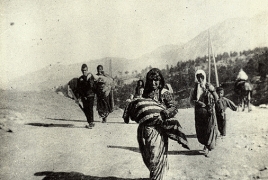
In April 1915, the Ottoman government embarked upon the systematic decimation of its civilian Armenian population. The persecutions continued with varying intensity until 1923 when the Ottoman Empire ceased to exist and was replaced by the Republic of Turkey. The Armenian population of the Ottoman state was reported at about two million in 1915. An estimated one million had perished by 1918, while hundreds of thousands had become homeless and stateless refugees. By 1923 virtually the entire Armenian population of Anatolian Turkey had disappeared.
Still, at the end of the 19th century, the despotic Turkish Sultan Abdul Hamid II–obsessed with loyalty above all, and infuriated by the nascent Armenian campaign to win basic civil rights–declared that he would solve the “Armenian question” once and for all. “I will soon settle those Armenians,” he told a reporter in 1890. “I will give them a box on the ear which will make them…relinquish their revolutionary ambitions.” Between 1894 and 1896, this “box on the ear” took the form of a state-sanctioned pogrom. In response to large scale protests by Armenians, Turkish military officials, soldiers and ordinary men sacked Armenian villages and cities and massacred their citizens. Hundreds of thousands of Armenians were murdered.
In 1908, a new government came to power in Turkey. A group of reformers who called themselves the “Young Turks” overthrew Sultan Abdul Hamid and established a more modern constitutional government. At first, the Armenians were hopeful that they would have an equal place in this new state, but they soon learned that what the nationalistic Young Turks wanted most of all was to “Turkify” the empire. According to this way of thinking, non-Turks–and especially Christian non-Turks–were a grave threat to the new state
On April 24, 1915, the Armenian genocide began. That day, the Turkish government arrested and executed several hundred Armenian intellectuals. After that, ordinary Armenians were turned out of their homes and sent on death marches through the Mesopotamian desert without food or water. Frequently, the marchers were stripped naked and forced to walk under the scorching sun until they dropped dead. People who stopped to rest were shot.
At the same time, the Young Turks created a “Special Organization,” which in turn organized “killing squads” or “butcher battalions” to carry out, as one officer put it, “the liquidation of the Christian elements.”
Although modern Turkey cynically rejects the fact of the Armenian Genocide, many Turkish intellectuals, including scholar Taner Akcam, one of the first Turkish academics to acknowledge and openly discuss the Armenian Genocide and a leading international authority on the subject, Orhan Pamuk, a Turkish novelist, screenwriter, academic and recipient of the 2006 Nobel Prize in Literature, Ragip Zarakolu, a Turkish human rights activist and publisher who has long faced legal harassment for publishing books on controversial subjects in Turkey, especially on minority and human rights in Turkey, as well as a number of others have recognized this crime against humanity committed at the hands of the Ottoman Empire.
On April 23, 2015, the ceremony of canonization of the Armenian Genocide victims took place in Holy Etchmiadzin, with the bells of churches ringing and a moment of silence.
60 foreign delegations, presidents of Russia, France and Cyprus, have arrived in Yerevan to participate in the Armenian Genocide centennial commemoration events.
Documentaries and feature films telling about the Genocide will be screened and world-known orchestras will perform concerts to honor the memory of the innocent victims.

